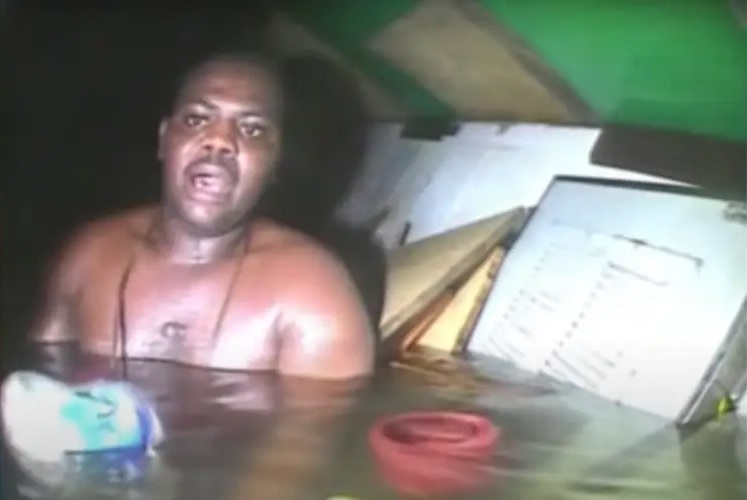The Incredible Survival Story of Harrison Okene: From Ocean Nightmare to Deep-Sea Diver

Imagine being trapped underwater for three days inside a flipped boat, with sea creatures nibbling at your skin. This isn’t a scene from a movie—it’s the real-life story of Harrison Okene, a man who survived one of the most terrifying ocean accidents ever recorded.
Today, he’s not only alive but has transformed his trauma into a new career as a professional diver. Let’s dive into his journey of courage, faith, and rebirth.
The Day Everything Changed
In May 2013, Harrison Okene, a 29-year-old Nigerian ship cook, was working aboard the Jascon-4 tugboat off Nigeria’s coast. The vessel was part of a crew supporting an oil tanker when disaster struck. A massive wave hit the boat, flipping it upside down and sending it plummeting 100 feet (30 meters) to the ocean floor.
Okene was in the bathroom when the wave crashed into the ship. Within moments, he found himself trapped in complete darkness as freezing water flooded the vessel. “I heard screams, then everything went silent,” he later recalled. The boat’s sudden capsizing killed 11 of his crewmates instantly.
Trapped in a Watery Grave
As the boat sank, Okene fought to survive. He struggled to open a jammed door while water rose around him. With limited oxygen and no escape route, he managed to find a small air pocket in a cabin—a tiny space that would become his home for the next three days.
How did he stay alive?
- Resourcefulness: Okene used flashlights to navigate the pitch-black wreck.
- Faith: He prayed constantly, believing divine intervention would save him.
- Supplies: He scavenged Coca-Cola bottles and a few snacks from the flooded kitchen.
- Mind Over Fear: “Panic uses too much oxygen,” he said. “I had to kill the fear inside me.”
But survival came at a gruesome cost. Crayfish lurking in the flooded cabin began biting his legs and arms. “It felt like needles pricking my skin,” he described. To stay above water, he built a makeshift raft from cushions and plywood.
The Science of Survival: How Air Pockets Work
Dr. Eric Hexdall, a diving medicine expert at Duke University, explained that Okene’s air pocket likely contained enough oxygen to last 56 hours. But rising carbon dioxide levels from his own breath posed a deadly risk. Okene’s calmness—slowing his breathing and avoiding panic—stretched his survival window beyond scientific predictions.
Rescue: A Miraculous Discovery
After 60 hours underwater, hope arrived. Divers sent to recover bodies spotted a pale hand floating in the wreckage. Assuming it was a corpse, one diver grabbed the hand—only for Okene to grip back.
“He’s alive! He’s alive!” the diver shouted in shock. Bodycam footage shows the emotional moment Okene emerged from the air pocket, shivering but conscious. Rescuers kept him calm, patting his shoulder as they prepared him for ascent.
The journey to the surface required careful decompression to avoid fatal pressure changes. Okene spent another 48 hours in a medical chamber before reuniting with his family.
Why Return to the Ocean?
After surviving such a nightmare, most people would avoid the ocean forever. But Okene felt drawn back. “The water has always been peaceful for me,” he told The Guardian.
In 2015, he faced his fears head-on by training as a commercial diver. “I wanted to conquer this once and for all,” he said. Today, he repairs underwater oil and gas equipment, diving to depths of 165 feet (50 meters)—deeper than the wreck that nearly killed him.
Life as a Diver: Healing Through the Waves
Okene’s job is physically demanding and mentally intense. Tasks include:
- Welding underwater pipelines.
- Inspecting equipment for damage.
- Navigating dark, cold environments reminiscent of his ordeal.
Yet he finds purpose in his work. “Every dive reminds me I’m stronger than my fears,” he says. His story inspires coworkers and trainees, proving that trauma can fuel transformation.
What Experts Say About Survival Odds
Few people survive shipwrecks in inverted vessels. Factors that helped Okene beat the odds:
- Air Pocket Location: Higher spots in capsized boats trap breathable air.
- Temperature: Cold water slowed his metabolism, reducing oxygen use.
- Mindset: His ability to stay rational and conserve energy was critical.
- The Psychological Battle: Overcoming PTSD
Post-rescue, Okene struggled with nightmares and guilt. “Why did I live when others died?” he wondered. Therapy and diving helped him heal. “The ocean took my friends, but it also gave me a second chance,” he reflects.
Harrison’s Message to the World
Okene now shares his story to inspire others. His advice?
“Fear is natural, but don’t let it control you.”
“Even in darkness, there’s a flicker of hope.”
“Your worst moment can lead to your greatest purpose.”
Conclusion: A Story of Human Resilience
Harrison Okene’s survival defies logic. From crayfish bites to freezing darkness, he endured horrors most can’t imagine. Yet his journey didn’t end with rescue—it began anew. By returning to the ocean, he transformed tragedy into triumph, proving that courage and purpose can rise from the depths of despair.
His story isn’t just about survival. It’s a reminder that even in our darkest hours, we have the power to rewrite our futures.
